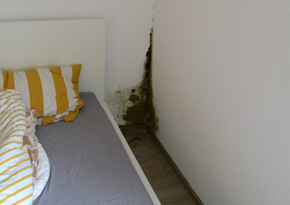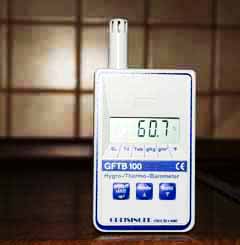 Mold grew nearly overnight – Sylvia Bittner couldn’t believe her eyes when she moved the bed in the children’s room to one side. Within two weeks, a dark turf of mold had grown on the wallpaper from the base to a height of forty centimeters. Sylvia had only moved into the rented apartment on the second floor with her family in the summer. The realtor had told her nothing about a mold problem and the apartment had been freshly painted. In late November, mold growth came upon the residents out of the blue. Sylvia picked up the phone and reported the matter to the property manager. When after eight days there was still no remedy in sight, the worried mother of two asked the consumer advice center. The friendly lady on the phone advised her to record the damage with a camera and to put the property management in default in writing. The advicer recommended that the rent payment be made with reservations so that she could later assert claims for repayment. But Sylvia Bittner was not thinking about money at first – she was much more concerned about the health of her children.
Mold grew nearly overnight – Sylvia Bittner couldn’t believe her eyes when she moved the bed in the children’s room to one side. Within two weeks, a dark turf of mold had grown on the wallpaper from the base to a height of forty centimeters. Sylvia had only moved into the rented apartment on the second floor with her family in the summer. The realtor had told her nothing about a mold problem and the apartment had been freshly painted. In late November, mold growth came upon the residents out of the blue. Sylvia picked up the phone and reported the matter to the property manager. When after eight days there was still no remedy in sight, the worried mother of two asked the consumer advice center. The friendly lady on the phone advised her to record the damage with a camera and to put the property management in default in writing. The advicer recommended that the rent payment be made with reservations so that she could later assert claims for repayment. But Sylvia Bittner was not thinking about money at first – she was much more concerned about the health of her children.
How dangerous are mold spores in indoor air?
The magazine “Apothekenumschau” dealt with the topic in its July 2014 issue. Dr. Markus Allewelt, a lung specialist from Berlin, reports allergic reactions in people with a corresponding predisposition. Immunocompromised individuals are at even greater risk. “Here it can come to infections with sometimes severe courses,” says the senior physician. Fungi from the genus “Aspergillus” are particularly feared. Aspergillosis primarily affects the lungs, ears and sinuses. In rarer cases, the skin, central nervous system and internal organs are also affected. Infections of the sinuses may cause fever or discharge from the nose or ears. Allergic reactions may have the typical symptoms of asthma with coughing and shortness of breath.
In an article in the journal Umwelt-Medizin-Gesellschaft (3/2010), Dr. Thomas Fenner from Hamburg summarizes the diagnostic possibilities: “Medicine has various methods at its disposal to narrow down the health effects of mold exposure at the workplace or in the home. Since there is not one or some special laboratory-diagnostic test, which proves the statement of a disease-causing load-carrying mold exposure, the diagnostics is multilayered. It always begins with a detailed anamnesis, in order to clarify, where which complaints in which form are provable. Recurrent infections, sinusitis, fatigue, exhaustion and lack of drive are frequently mentioned as symptoms. However, these symptoms can also occur with numerous other diseases. It can be meaningful to leave the dwelling over a period of fourteen days, in order to recognize a connection between complaints and environment.”
Remove mold quickly when danger is imminent
Sylvia Bittner is concerned about the health of her two children and does not want to wait until a craftsman finally has time to deal with her problem. The only question is which means promise success and how lasting the effect is. Consumer protection agencies recommend quick surface cleaning with agents containing alcohol, as the side effects are lowest here. The alcohol should have a concentration of at least seventy percent. Isopropyl alcohol can be bought in pharmacies; ethanol called methylated spirits can also be found in drugstores or hardware stores. Hydrogen peroxide is sold in small quantities in pharmacies with a clear recommendation for action, because the substance is explosive. The areas with visible growth are sprayed or dabbed and then left to act for thirty minutes. When rubbing, it is essential to wear protective equipment, at least an FFP2 mask and gloves. Infested wallpaper is removed immediately and disposed of. This is not the end of the job. All surfaces must be cleaned of dust – either by vacuum cleaner with HEPA filter or in smooth places with a damp wipe. And the hidden places must not be forgotten, for example, behind cabinets, under beds and in the corners of the room.
A hygrometer for measuring humidity and temperature belongs in every home
 Measuring the indoor climate with a hygrometerSylvia Bittner is now alarmed. She reads technical articles and finds out that molds need moisture to grow. As a food source for certain types of fungi, the variously present house dust is sufficient. Humidity occurs in every household to a greater or lesser extent. Only the values should not exceed certain limits. A hygrometer (see photo on the left) is used for control. This wonderful electronic device measures at least the room temperature and the relative humidity – available from thirty euros upwards in electronics stores or hardware stores. Professional devices can do even more: display the air pressure, convert the relative humidity into absolute humidity or store the values over a longer period of time using a data logger. To get started, it is sufficient for non-professionals to regularly document the values and define limits. After all, relative humidity should not exceed seventy percent. Otherwise, the moist air will settle in the coldest part of the room and possibly turn into condensation. Ms. Bittner now also makes sure that beds and cupboards are not placed directly against the outside walls. Otherwise, the circulating warm air in the room will not reach the covered areas. As a result, the surfaces cool down and ensure that the moist air condenses there.
Measuring the indoor climate with a hygrometerSylvia Bittner is now alarmed. She reads technical articles and finds out that molds need moisture to grow. As a food source for certain types of fungi, the variously present house dust is sufficient. Humidity occurs in every household to a greater or lesser extent. Only the values should not exceed certain limits. A hygrometer (see photo on the left) is used for control. This wonderful electronic device measures at least the room temperature and the relative humidity – available from thirty euros upwards in electronics stores or hardware stores. Professional devices can do even more: display the air pressure, convert the relative humidity into absolute humidity or store the values over a longer period of time using a data logger. To get started, it is sufficient for non-professionals to regularly document the values and define limits. After all, relative humidity should not exceed seventy percent. Otherwise, the moist air will settle in the coldest part of the room and possibly turn into condensation. Ms. Bittner now also makes sure that beds and cupboards are not placed directly against the outside walls. Otherwise, the circulating warm air in the room will not reach the covered areas. As a result, the surfaces cool down and ensure that the moist air condenses there.
More information
https://www.imd-potsdam.de/fileadmin/user_upload/Diag_Info/327_Diagnostik_Schimmelpilz-assoziierter_Erkrankungen.pdf (in German – please translate)
https://www.ibp.fraunhofer.de/content/dam/ibp/ibp-neu/de/dokumente/dissertationen/ks_dissertation_tcm45-30724.pdf (in German – please translate)
